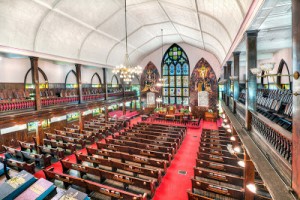They are the oldest AME* congregation in the South. They are one of the oldest African American congregations south of Baltimore MD. The congregation was originally formed in 1816, much as its denominational affiliate, over discrimination by the white Christians, mostly Methodists, in Charleston. This time it reached a braking point for the African Americans when the white population built a hearse shed atop the black burial ground.
The Revd Morris Brown, a black leader in the Methodist Episcopal Church in Charleston, withdrew from the MEC and organized a separate congregation for African Americans in Charleston. Reportedly 4000 black people followed him to the new church which was quickly affiliated with the African Methodist Episcopal Church founded in Philadelphia PA by the Rt Revd Richard Allen.
South Carolina state and Charleston city laws placed heavy restrictions on black churches in the early part of the 19th Century. The congregations were limited to holding worship services during daylight. The majority of members in a particular church needed to be white. Churches could not promote literacy among African Americans.The congregation founded by Brown was raided by the city 1818, 1820 and 1821. In the 1818 raid, 140 black members were arrested. 8 church leaders were sentenced to fines and lashes with a whip. A former slave from the Virgin Islands, Denmark Vesey, and a founding member of the church, was organizing a slave revolt in Charleston. He had been the personal servant of slavetrader Captain Joseph Vesey. Capt Vesey had set tled in Charleston in 1783. Authorities were informed of the planned revolt. Denmark Vesey and five others were convicted by secret trial and executed. The original church was mysteriously burned down, believed to be the work of White Supremacists.
tled in Charleston in 1783. Authorities were informed of the planned revolt. Denmark Vesey and five others were convicted by secret trial and executed. The original church was mysteriously burned down, believed to be the work of White Supremacists.
The discovery of the planned slave revolt caused hysteria among whites throughout the South. In 1834, churches with all black memberships were outlawed in Charleston. The congregation continued to meet in secret until the end of the Civil War in 1865. The Revd Brown could never be implicated of knowledge of the planned revolt but he eventually moved to Philadelphia where he became the AME Church’s second bishop.
In 1865, with the conclusion of the war, the congregation was reorganized and chose the name Emanuel, Hebrew for God is with US!
After the war, AME Bishop Daniel Payne, sent the Revd Richard Cain to pastor the congregations that became Emanuel AME and Brown AME. The Revd Cain later served in both the SC Senate and the US House of Representatives. From 1865 until 1872 the church the congregation built up Emanuel Church as a 2-story wooden structure on the current property. The project was led by Robert Vesey, architect and son of one of the church’s founders, Denmark Vesey. The property was on the north side of Boundary St, later Calhoun St, as blacks were unwelcome on the south side.That building was later destroyed during an earthquake 31 AUG 1886.
The present building was finished in 1891 during the pastorate of the Revd L Ruffin Nichols. During a remodel from 1949 to 1951, the bodies of the Revd & Mrs Nichols were entombed at the base of the steeple.
Through the years well-known African Americans have been invited to speak to the congregation, including Booker T Washington and the Revd Dr Martin Luther King, Jr. During the 1950s the congregation was at its largest modern day membership at around 2500. The membership is more than 1600 today. The church has a seating capacity of 2500.
The congregation’s most recent senior pastor, the late Revd Clementa Pinckney, had continued the tradition of black pastors also serving in public office. At the time of his death, he was a South Carolina State Senator.
The information for this story was gathered here, here and here.
Posted by David Allen

